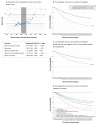What is the aetiology of dysnatraemia in COVID-19 and how is this related to outcomes in patients admitted during earlier and later COVID-19 waves? A multicentre, retrospective observational study in 11 Dutch hospitals
- PMID: 37963704
- PMCID: PMC10649520
- DOI: 10.1136/bmjopen-2023-075232
What is the aetiology of dysnatraemia in COVID-19 and how is this related to outcomes in patients admitted during earlier and later COVID-19 waves? A multicentre, retrospective observational study in 11 Dutch hospitals
Abstract
Objectives: To evaluate the relationship among dysnatraemia at hospital presentation and duration of admission, risk of intensive care unit (ICU) admission and all-cause mortality and to assess the underlying pathophysiological mechanism of hyponatraemia in patients with COVID-19. Our hypothesis is that both hyponatraemia and hypernatraemia at presentation are associated with adverse outcomes.
Design: Observational study.
Setting: Secondary care; 11 Dutch hospitals (2 university and 9 general hospitals).
Participants: An analysis was performed within the retrospective multicentre cohort study COVIDPredict. 7811 patients were included (60% men, 40% women) between 24 February 2020 and 9 August 2022. Patients who were ≥18 years with PCR-confirmed COVID-19 or CT with COVID-19 reporting and data system score≥4 and alternative diagnosis were included. Patients were excluded when serum sodium levels at presentation were not registered in the database or when they had been transferred from another participating hospital.
Outcome measures: We studied demographics, medical history, symptoms and outcomes. Patients were stratified according to serum sodium concentration and urinary sodium excretion.
Results: Hyponatraemia was present in 2677 (34.2%) patients and hypernatraemia in 126 (1.6%) patients. Patients with hyponatraemia presented more frequently with diarrhoea, lower blood pressure and tachycardia. Hyponatraemia was, despite a higher risk for ICU admission (OR 1.27 (1.11-1.46; p<0.001)), not associated with mortality or the risk for intubation. Patients with hypernatraemia had higher mortality rates (OR 2.25 (1.49-3.41; p<0.001)) and were at risk for ICU admission (OR 2.89 (1.83-4.58)) and intubation (OR 2.95 (1.83-4.74)).
Conclusions: Hypernatraemia at presentation was associated with adverse outcomes in patients with COVID-19. Hypovolaemic hyponatraemia was found to be the most common aetiology of hyponatraemia. Hyponatraemia of unknown aetiology was associated with a higher risk for ICU admission and intubation and longer duration of admission.
Keywords: COVID-19; infectious diseases; internal medicine.
© Author(s) (or their employer(s)) 2023. Re-use permitted under CC BY-NC. No commercial re-use. See rights and permissions. Published by BMJ.
Conflict of interest statement
Competing interests: None declared.
Figures


References
-
- COVID-PREDICT-werkgroep . Klinisch Beloop Van COVID-19 in Nederland. NTVG 2021;165. - PubMed
Publication types
MeSH terms
Substances
LinkOut - more resources
Full Text Sources
Medical
